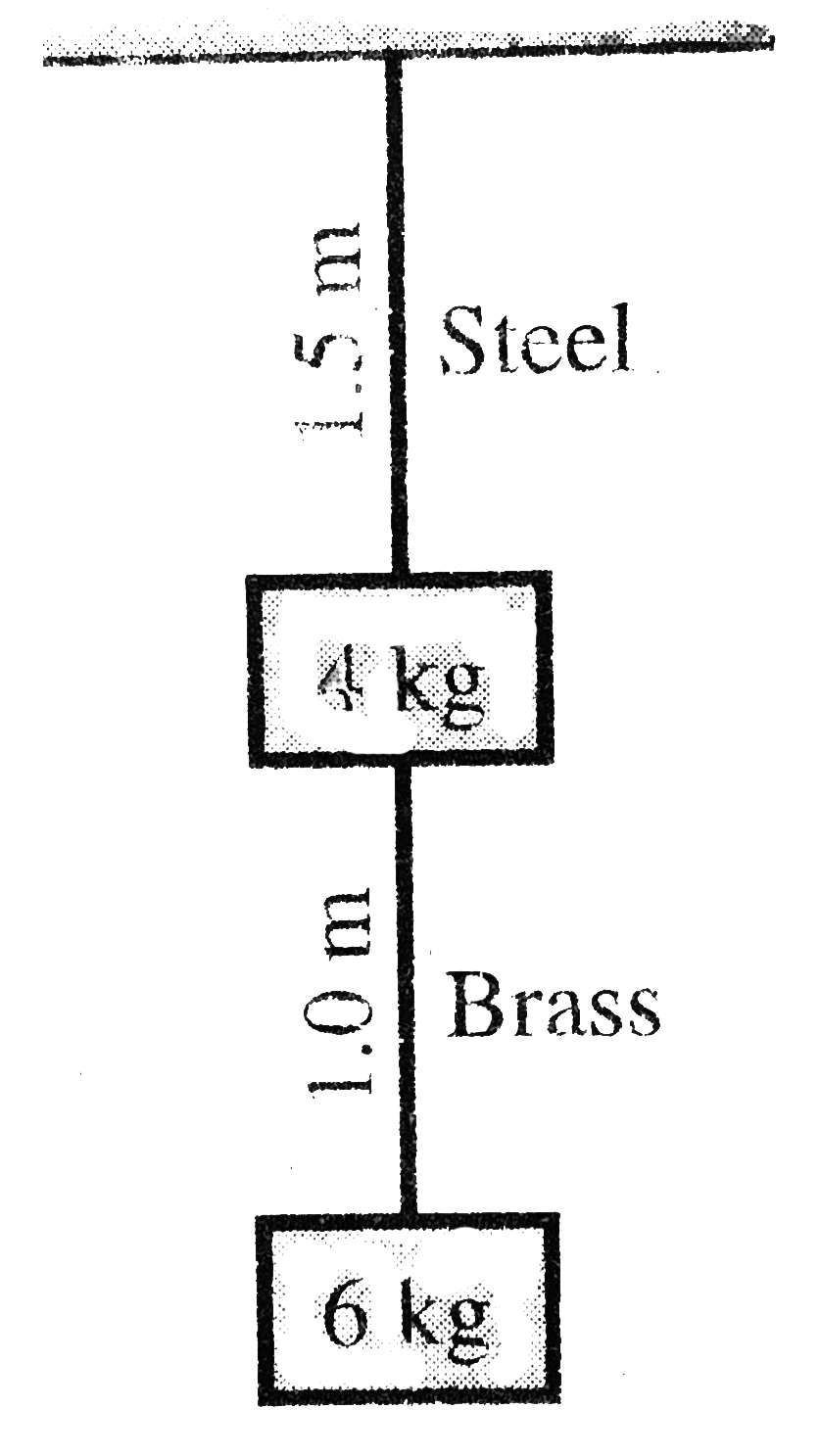A steel wire is 4.0 m long and 2 mm in diameter. Young’s modulus of steel is 1.96×1011N/m2. If a mass of 20 kg is suspended from it the elongation produced will be-
2.54 mm
1.27 mm
0.64 mm
0.27 mm
To solve the problem of elongation produced in a steel wire when a mass is suspended from it, we can follow these steps:
Step 1: Identify the given values
- Length of the wire (L) = 4.0 m
- Diameter of the wire (D) = 2 mm = 2 x 10^(-3) m
- Young’s modulus of steel (E) = 1.96 x 10^(11) N/m²
- Mass suspended (m) = 20 kg
- Acceleration due to gravity (g) = 9.8 m/s²
Step 2: Calculate the weight (W) of the mass
The weight can be calculated using the formula:
W=m⋅g
Substituting the values:
W=20kg⋅9.8m/s2=196N
Step 3: Calculate the cross-sectional area (A) of the wire
The area can be calculated using the formula for the area of a circle:
A=π4D2
Substituting the diameter:
A=π4(2×10−3)2
A=π4(4×10−6)
A=π×10−6m2
Step 4: Use the formula for stress (σ)
Stress (σ) is defined as the force (weight) per unit area:
σ=WA
Substituting the values:
σ=196Nπ×10−6
Step 5: Use the relationship between stress, Young's modulus, and strain
We know that:
σ=E⋅strain
Where strain is defined as:
strain=ΔLL
Thus:
σ=E⋅ΔLL
Rearranging gives:
ΔL=σ⋅LE
Step 6: Substitute the values to find elongation (ΔL)
First, calculate σ:
σ=196π×10−6≈6.24×108N/m2
Now substitute this into the equation for ΔL:
ΔL=(6.24×108)⋅41.96×1011
Step 7: Calculate ΔL
ΔL≈2.496×1091.96×1011≈0.0127m
Converting to mm:
ΔL≈0.0127×1000=12.7mm
Final Answer
The elongation produced in the steel wire is approximately 1.27 mm.
---
- Length of the wire (L) = 4.0 m
- Diameter of the wire (D) = 2 mm = 2 x 10^(-3) m
- Young’s modulus of steel (E) = 1.96 x 10^(11) N/m²
- Mass suspended (m) = 20 kg
- Acceleration due to gravity (g) = 9.8 m/s²
The weight can be calculated using the formula:
W=m⋅g
Substituting the values:
W=20kg⋅9.8m/s2=196N
The area can be calculated using the formula for the area of a circle:
A=π4D2
Substituting the diameter:
A=π4(2×10−3)2
A=π4(4×10−6)
A=π×10−6m2
Stress (σ) is defined as the force (weight) per unit area:
σ=WA
Substituting the values:
σ=196Nπ×10−6
We know that:
σ=E⋅strain
Where strain is defined as:
strain=ΔLL
Thus:
σ=E⋅ΔLL
Rearranging gives:
ΔL=σ⋅LE
First, calculate σ:
σ=196π×10−6≈6.24×108N/m2
Now substitute this into the equation for ΔL:
ΔL=(6.24×108)⋅41.96×1011
ΔL≈2.496×1091.96×1011≈0.0127m
Converting to mm:
ΔL≈0.0127×1000=12.7mm
The elongation produced in the steel wire is approximately 1.27 mm.
Topper's Solved these Questions
Similar Questions
Young 's modulus of steel is 2.0×1011Nm/(2). Express it is dynecm2.
View SolutionTwo wires of diameter 0.25cm, one made of steel and other made of brass, are loaded as shown in the figure. The unloaded length of the steel wire is 1.5m and that of brass is 1.0m. Young's modulus of steel is 2.0×1011Pa and that of brass is 1.0×1011 Pa. Compute the ratio of elongations of steel and brass wires. △lsteel△lbrass=?
 View Solution
View Solution
Knowledge Check
- Question 1 - Select One
A spring is made of material of Young's modulus 1011N/m2. When a weight of 10 kg is suspended vertically the elongation produced in the spring is 4 mm. If the load is reduced to half the elongation in the spring will be
A1 mmB4 mmC2 mmD0.2 mm - Question 2 - Select One
Young's modulus for steel is 2×1010N/m2. If the interatomic distance for steel is 3 Å, then the interatomic force constant for steel will be
A6×10−10N/mB6N/mC6×10−8N/mD60N/m - Question 3 - Select One
Young modulus of steel is 3×1011N/m2. When expressed in C.G.S. unit of Dyne/cm2 it will be equal to
A9×1012Dyne/cm2B9×1011Dyne/cm2C3×1012Dyne/cm2D3×1011Dyne/cm2
A steel wire4.0m in length is stretched through 2.0mm.The cross -sectional area of the wire is 2.0mm2.If young's modulus of steel is 2.0×1011N/m2
(a) the enrgy density of wire,
(b) the elastic potential energy stored in the wire.View SolutionA steel wire of 4.0 m is stretched through 2.0 mm. The cross - sectional area of the wire is 2.0mm2. If young's modulus of steel is 2.0×1011Nm−2 find (i) the energy density of the wire, (ii) the elastic potential energy stored in the wire.
View SolutionThe Young's modulus of steel is 2×1011N/m2. If the interatomic spacing of the metal is 2.5 Å. Then the interatomic force constant is,
View SolutionIf young's modulus of steel is 2×1011N/m2, then the force required to increase the length of a wire of cross section 1cm2 by 1% will be
View SolutionA structural steel rod has a radius r(=10 mm) and a length l(=1 m). When a force F(= 100 kN) is applied, it stretches it along its length. Young's modulus of elasticity of the structural steel is 2.0×1011Nm−2.
What is the elongation produced ?View Solution

